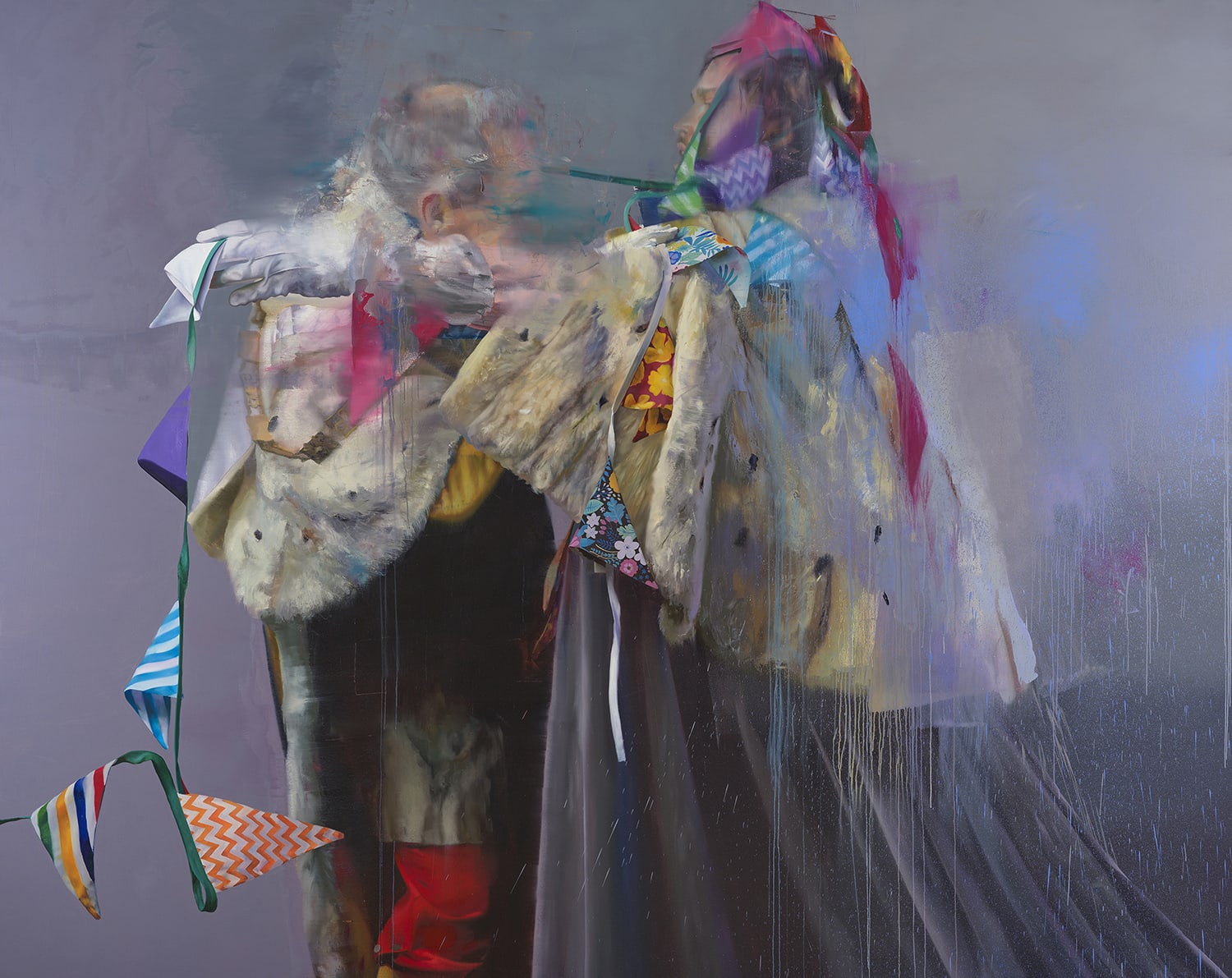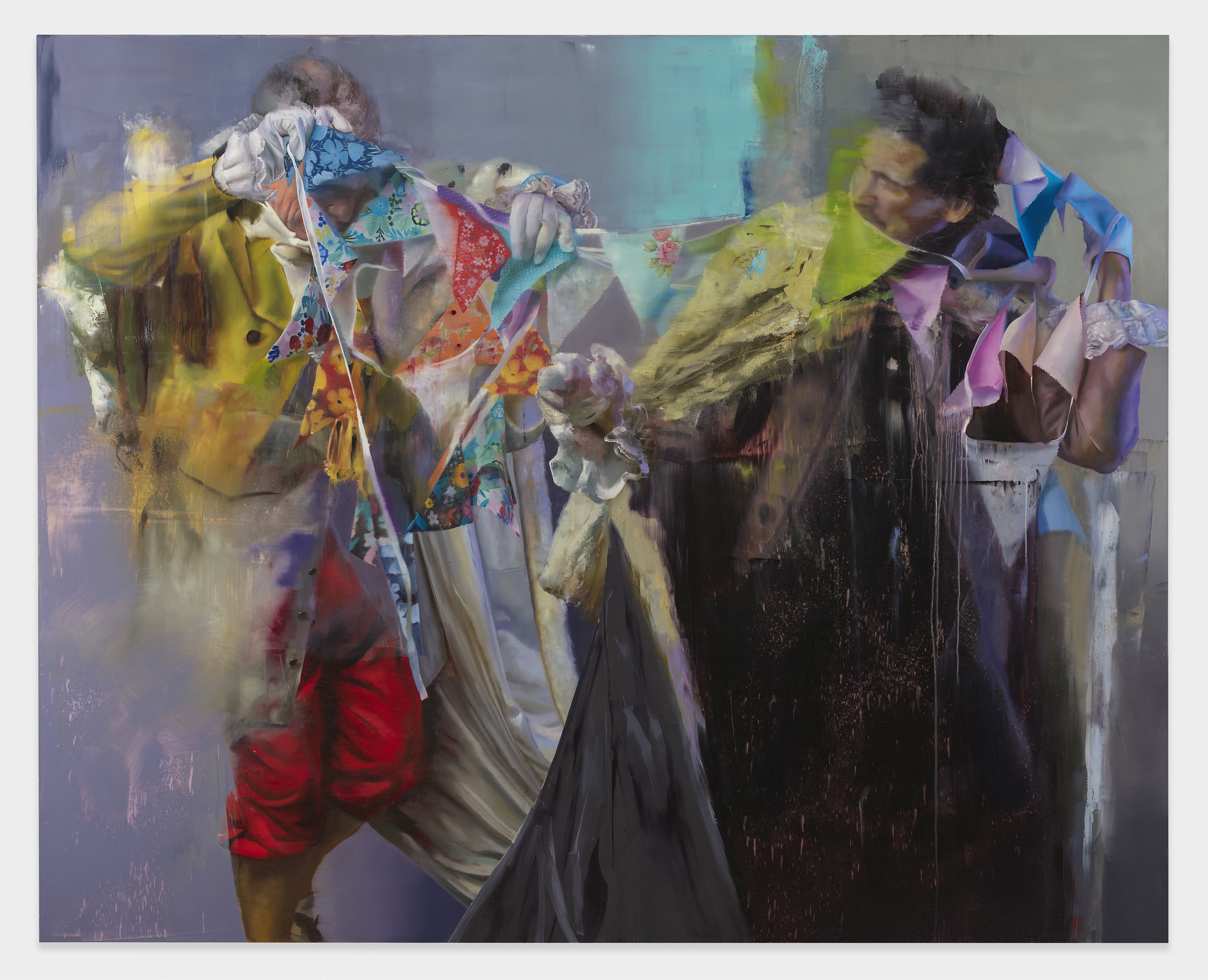Chloe Early: These new works depict a lot of ermine cloaks. I can almost feel the weight of the fabric through the painting, while the body underneath begins to crumble – the weight of history, rank and nobility seems too much to bear. I’m reminded of defunct stately homes, where families’ power and wealth have disintegrated to dust, and what was once a symbol of status and wealth creation becomes a burden, impossible to maintain. That’s my feeling about the cloaks – they’re too heavy to wear, too cumbersome and problematic, not just because they’re made of fur but because of all they represent. Still, here in the UK (where you live, work and are about to show this body of paintings) ermine cloaks are worn by members of the House of Lords and the royal family on ceremonial occasions, so they remain contemporary, relevant and powerful. How far do you think we’ve come towards toppling those archaic power structures – somewhat, or not at all?
Conor Harrington: The genesis of a lot of this work was the toppling of statues after the societal shift in 2020. I thought it was such a powerful act – people tearing down statues. It reminded me of that conversation in graffiti between painting and erasing. It also made me look back through history to remember that toppling statues has always happened: the Greeks, the Romans, American soldiers pulling down statues of Saddam Hussein in Iraq, and of course when the IRA blew up Nelson’s Pillar in Dublin in 1966. It has felt like more power has come back into the hands of the people, although as I sit and write this – in light of everything else happening around the world and the massive threat from AI looming – the future definitely feels more and more uncertain.

Welcome to the Cabaret, 2025
Oil and spray paint on linen
250 x 310 cm. (98 3/8 x 122 in.)
CE: In these paintings there are mostly two figures, involved in a tussle or fight, tangled in a web of bunting. It’s unclear whether they’re freeing themselves or becoming more trapped – a neat visual play on webs of power and status. The bunting is beautifully painted, and I know you tried three different approaches before finding one you were happy with, so well done for that. Bunting usually signals celebration, so its inclusion adds playfulness. Paired with the ermine-cloaked giants, it ridicules them but also humanises them – these men were once little boys whose mothers hung bunting for birthdays. Was that your point?
CH: I think my aim was to introduce an incongruous element to the historical costume, something that would be jarring, of another time and for a different purpose than the cloaks and ceremonial garb the men are wearing. I like all the alternative narratives that are suggested when you paint a light-hearted, celebratory bunting – strangling, struggling, and playing with the heavy and austere historical weight of the ermine cloak.
The playfulness is there in the bright stripes and polka dots. It’s a metaphorical and visual counterpoint to the seriousness of the cloaks. I tried different types of bunting, especially global flags – the type you see hanging in bars during the World Cup. I liked that idea, but I thought maybe it was leaning too obviously into colonialism, which is in my work anyway but didn’t need to be hammered home. I settled on the more fun and conventional bunting. I see each little triangle as a mini abstract piece, almost like a painting within a painting.
CE: The elements you give most time and significance to are costume and clothing. You use them symbolically, but they’re still fabric. Given my background in textile design, I find that interesting. Even though you’re a strong figure painter, your work is less about the body and more about systems of power suggested through costume and adornment. Is that right?
CH: I mainly see the abstract and painterly possibilities of fabric. I like how clothing can be described by either fully rendering the fabric or just splashing down a heavy roller to describe the piece. I’ve always been more attracted to the painting possibilities that clothing brings. I began painting a very different type of uniform – my friends wearing hoodies and baggy clothes. I loved the weight and the folds and how the clothing engulfed the figure. A lot of these earlier paintings featured their hoods up, hiding their identity and the fleshiness of the skin so they became more like abstract vessels than portraits.
I don’t often think about the person underneath the clothing. I like the weight of the costumes – there are so many layers. I only paint a few glimpses of flesh; I often forget that there’s a body underneath as the layers are so dense, but it can be a treat to get into those natural tones after days of painting the brighter coloured clothing. I like the politics of clothing, so for me and my paintings, clothing is a vehicle I can use to explore the issues that interest me.

The Bandits at the Ballet, 2025
Oil and spray paint on canvas
200 x 250 cm. (78 3/4 x 98 3/8 in.)
CE: I first saw your work as spray-painted question marks on overlooked corners of Cork, with subtle colour combinations – a turquoise mark on a rusty door panel beside a pink door – that caught my attention. I mention this as a way of introducing the formal qualities of your work: colour, texture, line, form. You paint form particularly well, especially fabric, but you also have an eye for colour. Do you think consciously about these qualities, or are they innate, an assumed foundation for your paintings?
CH: I’m most comfortable in black, white and grey. It’s so much easier to read and portray form in monochrome. I sometimes find colour a distraction and it’s definitely not something that has come easily to me.
Moving over to oils from graffiti and spray paint was a huge learning curve. You have to mix everything and it can be very hit and miss. I think because I found colour so frustrating to begin with, it’s made me try harder to make it work.
CE: I’ve always liked your overblown figures, breaching the canvas edges and imposing a larger-than-life presence on the viewer. I often see them as giants, metaphors for history and time – whether masculinity within societal structures or the history of painting itself. Both feel precarious today, so this work feels timely, if a little risky. Do you feel the past on your shoulder as you work, or are these just fun things to play with?
CH: I try to forget about the world when I paint but there’s no escaping it these days. I think I’m taking some of today’s issues more head-on in this show than in previous bodies of work, even if these paintings might also seem more subtle and ambiguous to a casual viewer. The historical element has always been more of a lens or a filter that I employ to examine contemporary issues. The past is definitely there – there’s no hiding from it when you paint large 18th-century costumes – but I see them more as a Trojan horse to enable me to sneak in other narratives.
Moving from outdoor walls to working in a studio brings about an obvious reduction in scale, so I tried to limit that on the canvas by keeping the figures as big as possible. I’ve always been interested in archetypes, characters who have traditionally been celebrated as near deities, so portraying them on a large scale is important, but at the same time it allows me the opportunity to zoom in and deconstruct them and their trappings. I’m interested in the precipice – that moment before a fall. I’m also very much interested in authority and questioning those we put on a pedestal. The larger the figure, the larger the fall.
CE: You’ve been working on this show for over a year – that’s a lot of painting hours. Around now interviewers usually ask, “What’s next?”, which feels cruel after all you’ve just made. So let me frame it differently: how do you feel about an empty studio? I know you have new ideas already, and you don’t linger as long as I do in the “what next” phase. How soon do you think you’ll start your next painting?
CH: I love looking around the empty studio as soon as all the paintings have been picked up, and then I love going to the gallery to see the paintings there. That’s a very important step in the process because a lot of the time I’m not sure how I feel about a body of work in the studio – it’s hard to see them properly with the paint-splashed walls and half-finished paintings lying around. So spending time with them in a clean gallery space with the right lighting is when I get some closure on a body of work. I’m looking forward to taking the time to digest them properly before moving on.





